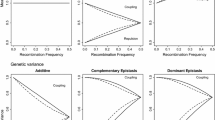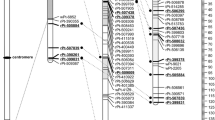Abstract
Recent progress in genotyping and doubled haploid (DH) techniques has created new opportunities for development of improved selection methods in numerous crops. Assuming a finite number of unlinked loci (ℓ) and a given total number (n) of individuals to be genotyped, we compared, by theory and simulations, three methods of marker-assisted selection (MAS) for gene stacking in DH lines derived from biparental crosses: (1) MAS for high values of the marker score (T, corresponding to the total number of target alleles) in the F2 generation and subsequently among DH lines derived from the selected F2 individual (Method 1), (2) MAS for augmented F2 enrichment and subsequently for T among DH lines from the best carrier F2 individual (Method 2), and (3) MAS for T among DH lines derived from the F1 generation (Method 3). Our objectives were to (a) determine the optimum allocation of resources to the F2 (\( \, n_{1}^{*} \)) and DH generations \( (n - n_{1}^{*} ) \) for Methods 1 and 2 by simulations, (b) compare the efficiency of all three methods for gene stacking by simulations, and (c) develop theory to explain the general effect of selection on the segregation variance and interpret our simulation results. By theory, we proved that for smaller values of ℓ, the segregation variance of T among DH lines derived from F2 individuals, selected for high values of T, can be much smaller than expected in the absence of selection. This explained our simulation results, showing that for Method 1, it is best to genotype more F2 individuals than DH lines (\( n_{1}^{*} :n > 0.5 \)), whereas under Method 2, the optimal ratio \( n_{1}^{*} :n \) was close to 0.5. However, for ratios deviating moderately from the optimum, the mean \( \overline{X} \) of T in the finally selected DH line (\( T_{\text{DH}}^{*} \)) was hardly reduced. Method 3 had always the lowest mean \( \overline{X} \) of \( T_{\text{DH}}^{*} \) except for small numbers of loci (ℓ = 4) and is favorable only if a small number of loci are to be stacked in one genotype and/or saving one generation is of crucial importance in cultivar development. Method 2 is under most circumstances the superior method, because it generally showed the highest mean \( \overline{X} \) and lowest SD of \( T_{\text{DH}}^{*} \) for the finally selected DH.




Similar content being viewed by others
References
Bernardo R (2008) Molecular markers and selection for complex traits in plants: learning from the last 20 years. Crop Sci 48:1649–1664
Bernardo R (2009) Should maize doubled haploids be induced among F1 or F2 plants? Theor Appl Genet 119:255–262
Bonnett DG, Rebetzke GJ, Spielmeyer W (2005) Strategies for efficient implementation of molecular markers in wheat breeding. Mol Breeding 15:75–85
Darrah LL, Zuber MS (1986) 1985 United States farm maize germplasm base and commercial breeding strategies. Crop Sci 26:1109–1113
David HA (1970) Order statistics. Wiley, NY
Fehr WR (1987) Principles of cultivar development, vol 1. Theory and technique. Macmillan Publishing Co, NY, p 136
Heffner EL, Lorenz AJ, Jannink J-L, Sorrells ME (2010) Plant breeding with genomic selection: gain per unit time and cost. Crop Sci 50:1681–1690
Hospital F, Dillmann C, Melchinger AE (1996) A general algorithm to compute multilocus genotype frequencies under various mating systems. CABIOS Oxford University Press 12:455–462
Howes NK, Woods SM, Townley-Smith TF (1998) Simulations and practical problems of applying multiple marker assisted selection and doubled haploids to wheat breeding programs. Euphytica 100:225–230
Kearsey MJ, Pooni HS (1996) The genetical analysis of quantitative traits. Chapman and Hall, London
Koide Y, Kawasaki A, Telebanco-Yanoria MJ, Hairmansis A, Nguyet NTM, Bigirimana J, Fujita D, Kobayashi N, Fukuta Y (2010) Development of pyramided lines with two resistance genes, Pish and Pib, for blast disease (Magnaporthe oryzae B. Couch) in rice (Oryza sativa L.). Plant Breeding 670–675
Lande R, Thompson R (1990) Efficiency of marker-assisted selection in the improvement of quantitative traits. Genetics 124:743–756
Longin CFH, Utz HF, Reif JC, Schipprack W, Melchinger AE (2006) Hybrid maize breeding with doubled haploids: I. One-stage versus two-stage selection for testcross performance. Theor Appl Genet 112:903–912
Longin CFH, Utz HF, Reif JC, Wegenast T, Schipprack W, Melchinger AE (2007) Hybrid maize breeding with doubled haploids: III. Efficiency of early testing prior to doubled haploid production in two-stage selection for testcross performance. Theor Appl Genet 115:519–527
Lynch M, Walsh B (1997) Genetics and analysis of quantitative traits. Sinauer Assoc, Sunderland
Mago R, Lawrence GJ, Ellis JG (2011) The application of DNA marker and doubled-haploid technology for stacking multiple stem rust resistance genes in wheat. Mol Breeding 27:329–335
Meuwissen THE, Hayes BJ, Goddard ME (2001) Prediction of total genetic value using genome-wide dense marker maps. Genetics 157:1819–1829
Mikel MA, Dudley JW (2006) Evolution of North American dent corn from public to proprietary germplasm. Crop Sci 46:1193–1205
Perumalsamy S, Bharani M, Sudha M, Nagarajan P, Arul L, Saraswathi R, Balasubramanian P, Ramalingam J (2010) Functional marker-assisted selection for bacterial leaf blight resistance genes in rice (Oryza sativa L.). Plant Breeding 129:400–406
R Development Core Team (2010) R: a language and environment for statistical computing. R Foundation for Statistical Computing, Vienna, Austria. ISBN 3-900051-07-0, URL http://www.R-project.org/
Röber FK, Gordillo GA, Geiger HH (2005) In vivo haploid induction in maize—performance of new inducers and significance of doubled haploid lines in hybrid breeding. Maydica 50:275–283
Schnell FW (1982) A synoptic study of the methods and categories of plant breeding. Z Pflanzenzüchtung 89:1–18
Tuvesson S, Dayteg C, Hagberg P, Manninen O, Tanhuanpää P, Tenhola-Roininen T, Kiviharju E, Weyen J, Förster J, Schondelmaier J, Lafferty J, Marn M, Fleck A (2007) Molecular markers and doubled haploids in European plant breeding programmes. Euphytica 158:305–312
Varshney RK, Nayak SN, May GD, Jackson SA (2009) Next generation sequencing technologies and their implications for crop genetics and breeding. Trends Biotechnol 27:522–530
Wang J, Chapman SC, Bonnett DG, Rebetzke GJ, Crouch J (2007) Application of population genetic theory and simulation models to efficiently pyramid multiple genes via marker-assisted selection. Crop Sci 47:582–590
Wędzony M, Forster BP, Żur I, Golemiec E, Szechyńska-Hebda M, Dubas E, Gotębiowska G (2009) Progress in doubled haploid technology in higher plants. In: Touraev A, Forster BP, Jain SM (eds) Advances in haploid production in higher plants. Springer Science + Business Media BV, Heidelberg, pp 1–33
Wegenast T, Utz HF, Longin CFH, Maurer HP, Dhillon BS, Melchinger AE (2010) Hybrid maize breeding with doubled haploids: V. Comparison of selection strategies involving variable sizes of crosses and S1 families in two-stage selection for testcross performance. Theor Appl Genet 120:699–708
Wu Y (2010) Molecular breeding. CAB International, Oxfordshire
Author information
Authors and Affiliations
Corresponding author
Additional information
Communicated by J. Wang.
A. E. Melchinger and F. Technow contributed equally.
Electronic supplementary material
Below is the link to the electronic supplementary material.
Rights and permissions
About this article
Cite this article
Melchinger, A.E., Technow, F. & Dhillon, B.S. Gene stacking strategies with doubled haploids derived from biparental crosses: theory and simulations assuming a finite number of loci. Theor Appl Genet 123, 1269–1279 (2011). https://doi.org/10.1007/s00122-011-1665-x
Received:
Accepted:
Published:
Issue Date:
DOI: https://doi.org/10.1007/s00122-011-1665-x




